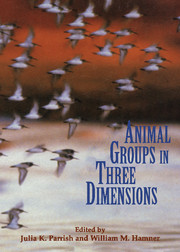Book contents
- Frontmatter
- Contents
- List of contributors
- Acknowledgments
- 1 Introduction – From individuals to aggregations: Unifying properties, global framework, and the holy grails of congregation
- Part one Imaging and measurement
- Part two Analysis
- Part three Behavioral ecology and evolution
- Part four Models
- References
- Subject index
- Taxonomic index
1 - Introduction – From individuals to aggregations: Unifying properties, global framework, and the holy grails of congregation
Published online by Cambridge University Press: 01 June 2010
- Frontmatter
- Contents
- List of contributors
- Acknowledgments
- 1 Introduction – From individuals to aggregations: Unifying properties, global framework, and the holy grails of congregation
- Part one Imaging and measurement
- Part two Analysis
- Part three Behavioral ecology and evolution
- Part four Models
- References
- Subject index
- Taxonomic index
Summary
Seeing is believing
An aggregation of anything against a background of sameness captures our eye. Congregations of creatures that routinely swarm and cluster or crowd together capture our imagination and generate new descriptive, often florid, collective terms for groups of living things; descriptors that are species-specific and etymologically precise (see Lipton's “Exaltation of Larks,” 1991). A swarm of bees, a host of sparrows, and a smack of jellyfish generate crisp images in our mind's eye, while a cloud of goats, a gaggle of flies, and a pod of parrots only generate confusion. There is no collective term in the English language for this wealth of collective adjectives (Lipton 1991), other than terms of “venery” (from the Latin venari, to hunt game), words that initially described aggregations of game animals, clustered conveniently for the huntsman.
Some of these terms denote protean behavioral displays that are visually compulsive. However, when our congregations of creatures are behaviorally coordinated in space and time, synchronously moving and wheeling and twisting before us in three-dimensional space, as in a school of smelt or a flock of phalaropes, they subvert our visual ability to focus on an individual animal and, somehow, suddenly the sum of the parts becomes a cohesive whole. Those of us who are terminally entranced with the three-dimensional, hypnotic beauty of synchronized flocks of birds and schools of fish quite simply cannot be cured. We know there is order within these three-dimensional displays, but it is not immediately obvious how to quantify it.
- Type
- Chapter
- Information
- Animal Groups in Three DimensionsHow Species Aggregate, pp. 1 - 14Publisher: Cambridge University PressPrint publication year: 1997
- 22
- Cited by



